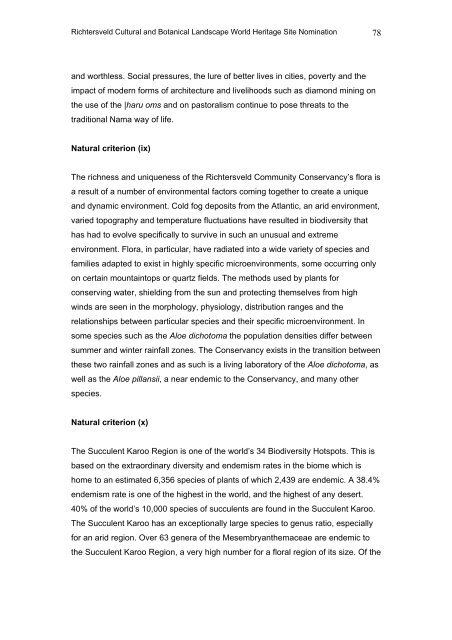the richtersveld cultural and botanical landscape - SAHRA
the richtersveld cultural and botanical landscape - SAHRA
the richtersveld cultural and botanical landscape - SAHRA
You also want an ePaper? Increase the reach of your titles
YUMPU automatically turns print PDFs into web optimized ePapers that Google loves.
Richtersveld Cultural <strong>and</strong> Botanical L<strong>and</strong>scape World Heritage Site Nomination 78<br />
<strong>and</strong> worthless. Social pressures, <strong>the</strong> lure of better lives in cities, poverty <strong>and</strong> <strong>the</strong><br />
impact of modern forms of architecture <strong>and</strong> livelihoods such as diamond mining on<br />
<strong>the</strong> use of <strong>the</strong> |haru oms <strong>and</strong> on pastoralism continue to pose threats to <strong>the</strong><br />
traditional Nama way of life.<br />
Natural criterion (ix)<br />
The richness <strong>and</strong> uniqueness of <strong>the</strong> Richtersveld Community Conservancy’s flora is<br />
a result of a number of environmental factors coming toge<strong>the</strong>r to create a unique<br />
<strong>and</strong> dynamic environment. Cold fog deposits from <strong>the</strong> Atlantic, an arid environment,<br />
varied topography <strong>and</strong> temperature fluctuations have resulted in biodiversity that<br />
has had to evolve specifically to survive in such an unusual <strong>and</strong> extreme<br />
environment. Flora, in particular, have radiated into a wide variety of species <strong>and</strong><br />
families adapted to exist in highly specific microenvironments, some occurring only<br />
on certain mountaintops or quartz fields. The methods used by plants for<br />
conserving water, shielding from <strong>the</strong> sun <strong>and</strong> protecting <strong>the</strong>mselves from high<br />
winds are seen in <strong>the</strong> morphology, physiology, distribution ranges <strong>and</strong> <strong>the</strong><br />
relationships between particular species <strong>and</strong> <strong>the</strong>ir specific microenvironment. In<br />
some species such as <strong>the</strong> Aloe dichotoma <strong>the</strong> population densities differ between<br />
summer <strong>and</strong> winter rainfall zones. The Conservancy exists in <strong>the</strong> transition between<br />
<strong>the</strong>se two rainfall zones <strong>and</strong> as such is a living laboratory of <strong>the</strong> Aloe dichotoma, as<br />
well as <strong>the</strong> Aloe pillansii, a near endemic to <strong>the</strong> Conservancy, <strong>and</strong> many o<strong>the</strong>r<br />
species.<br />
Natural criterion (x)<br />
The Succulent Karoo Region is one of <strong>the</strong> world’s 34 Biodiversity Hotspots. This is<br />
based on <strong>the</strong> extraordinary diversity <strong>and</strong> endemism rates in <strong>the</strong> biome which is<br />
home to an estimated 6,356 species of plants of which 2,439 are endemic. A 38.4%<br />
endemism rate is one of <strong>the</strong> highest in <strong>the</strong> world, <strong>and</strong> <strong>the</strong> highest of any desert.<br />
40% of <strong>the</strong> world’s 10,000 species of succulents are found in <strong>the</strong> Succulent Karoo.<br />
The Succulent Karoo has an exceptionally large species to genus ratio, especially<br />
for an arid region. Over 63 genera of <strong>the</strong> Mesembryan<strong>the</strong>maceae are endemic to<br />
<strong>the</strong> Succulent Karoo Region, a very high number for a floral region of its size. Of <strong>the</strong>

















